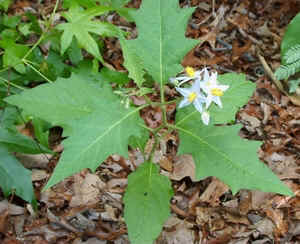 |
Common Name: Horse Nettle, Sandbrier, Bull Nettle, Apple-of-Sodom, Tread Softly
Scientific Name: Solanum carolinense
Family: Solanaceae
Serendipity Ranch
Columbus, North Carolina
June 7, 2002
 |
This prickly, rhizomatous perennial has simple or weakly branched stems usually 8-24 inches tall and flowers about 1 inch broad. The naked, globular, dull berries that follow are about 1/2 inch in diameter. A weedy native of the eastern U.S. that grows in old fields, gardens, waste places, and on roadsides throughout the state. May-July [Justice, William S. and Bell, C. Ritchie, Wild Flowers of North Carolina. University of North Carolina Press, Chapel Hill, 1968]
Though this is a rather ugly-looking little plant, it does have an attractive pale-blue-to-white flower with a conspicuously protruding yellow center. The 3- to 5-inch-long leaves are elliptic, rough, coarsely lobed, and covered with prickles. The stems are covered with rough thorns. This noxious weed, known also as Sandbrier, Bull Nettle, Apple-of-Sodom, and Tread Softly, belongs to the nightshade family, whose members, like horse-nettle, are often armed with thorns and spines. In times past it has been used in the treatment of epilepsy and recommended as a remedy for asthma, bronchitis, and other convulsive disorders. It grows in sandy soil, in waste areas, and along roadsides. June-September [Alderman, J. Anthony, Wildflowers of the Blue Ridge Parkway. The University of North Carolina Press, Chapel Hill, 1997]
The star-shaped flowers are white to violet with five wide lobes. Protruding yellow anthers form a beak in the center of the flower. The branched stem (1 to 4 feet tall) and the rough, irregularly lobed leaves are prickly. The fruit is an orange or yellow berry. The highly toxic horse nettle and bittersweet nightshade come from the same family as tomatoes, potatoes, and eggplants. Horse nettle, which grows in grazing pastures, has frequently been associated with livestock poisoning. Cattle will not knowingly eat it, but it often gets mixed in with their hay. Prickles on the plant can cause painful wounds and should be avoided. The berries of horse nettle were once considered useful as an antispasmodic for the treatment of epilepsy. We don't except to see too many photographers plunge through a cow pasture at 6:00 A.M. to photograph horse nettle, but those who do will be rewarded with a surprisingly photogenic wildflower. Of course, shooting while it is still covered in morning dew makes it even better. Two pieces of advice: watch where you step, and look out for bulls! Trust us on this, folks. May-September [Adams, Kevin and Casstevens, Marty, Wildflowers of the Southern Appalachians: How to Photograph and Identify Them. John F. Blair, Publisher, Winston-Salem, 1996]
January February March April May June July August September October November December
Alphabetical Listings -- A B C D, E F G H I, J, K L M N, O P Q, R S T U, V W X, Y, Z
Family Listings -- A B C D, E F G H I, J, K L M N, O P Q, R S T U, V W X, Y, Z
Genus Listings -- A B C D, E F G H I, J, K L M N, O P Q, R S T U, V W X, Y, Z